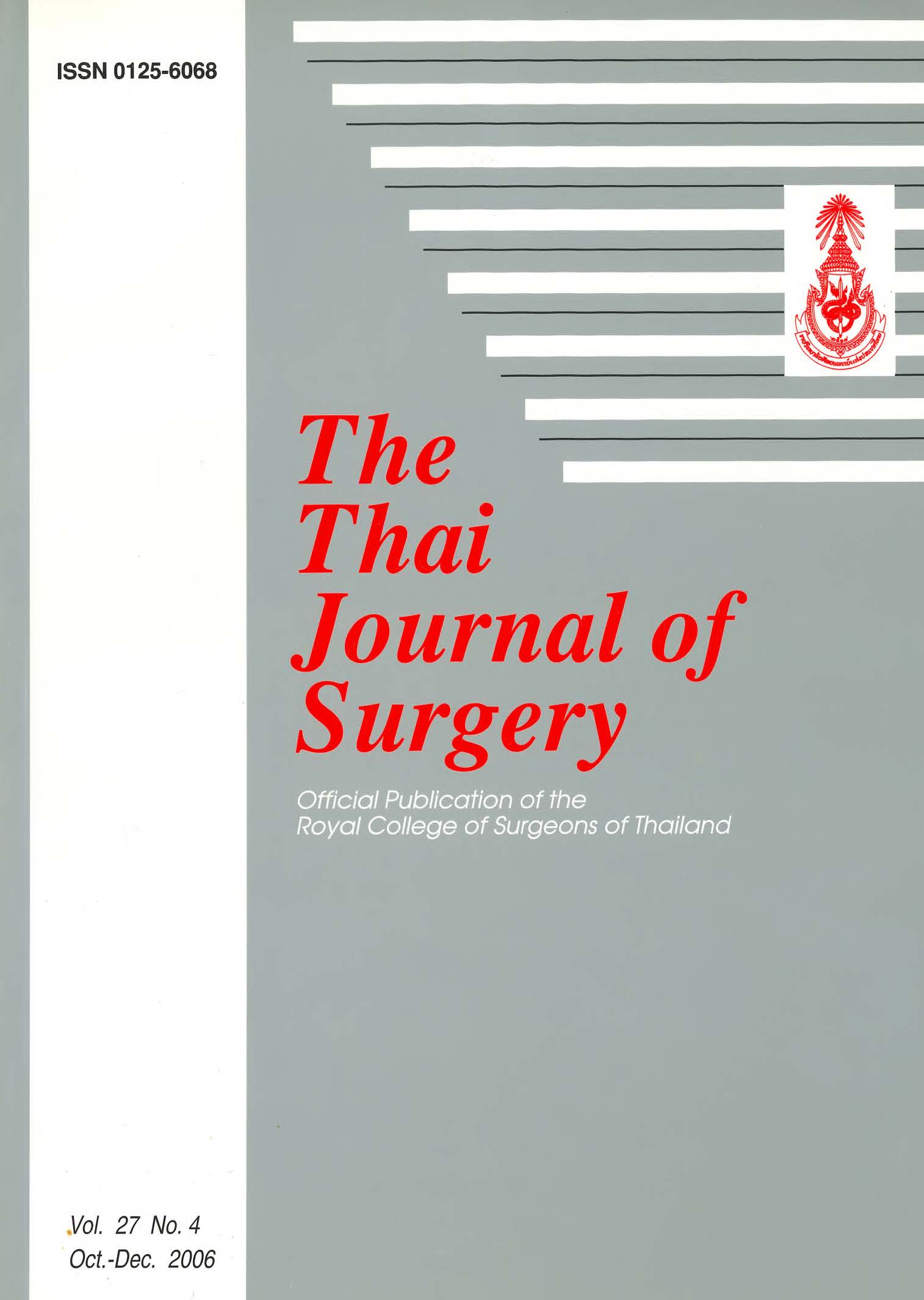Urological Complications in Gynecologic and Obstetric Operations at Surin Hospital
Abstract
Objectives: To review the causes, treatment and morbidity associated with iatrogenic urological injuries in gynecologic and obstetric surgery.
Materials and Methods: From 2002 to 2006, the medical records of all patients with the diagnosis of iatrogenic ureteral and bladder injuries were reviewed and 10 cases with 11 injuries were identified.
Results: Intraoperative injuries were recognized in 4 cases (2 cases of cut ureter and 2 cases of bladder tear). Delayed complications occurred in 7 cases including 2 V-V fistulae and 5 U-V fistulae. Endometriosis which accounted for 5 of 7 cases was the common diagnosis in the ureteral injury group. V-V fistulae were repaired transabdominally. Ureteral injuries were treated by reimplantation of ureter with or without native bladder bridge. All patients recovered with no further complications.
Conclusions: Proper identification and, when necessary, isolation of the ureter during operations in high risk group is crucial in reducing the incidence of urological injuries. Urological consultation should be considered in high risk patients.
References
2. Selzman AA, Spirnak JP. latrogenic ureteral injuries: A 20-year experience in treating 165 injuries. J Urol 1996;155:878-81.
3. Miller EA, Webster GD. Current management of vesicovaginal fistular. Curr Opin Urol 2001; 11: 417.
4. Witters C, Connelissen M, Vereccken R. latrogenic ureteral injury: aggressive or conservative treatment. Am J Obstet Gynecol 1986;155:582-4.
5. Grace PA, Murphy DM, Butler MR. Surgical injury to the ureter: a report of 21 injuries in 19 patients. Int Med J 1983;76:418-20.
6. Flynn JT, Tiptaft RC, Woodhouse CRJ, Paris AMI, Blandy Jp, The early and aggressive repair of iatrogenic ureteric injuries, Brit J Urol 1979; 51: 454.
7. Hoch WH, Kursh ED, Persky L. Early aggressive management of intraoperative ureteral injuries. J Urol 1975; 144: 530.
8. Blandy JP, Badenoch DF, Fowler CG, Jenkins BJ, Thomas NWM, Early repair of iatrogenic injury to the ureter or bladder after gynecological surgery. J Urol 1991; 146:761.
9. Theobald VP, Hamel P, Febbraro W, Laparoscopic repair of a vesicovaginal fistula using an omental J flap. Br J Obstet Gynecol 1998;105:1216.
10. Eilber KS, Kavaler E, Rodriguez LV, Rosenblum N, Shlomo R. Ten-year experience with transvaginal vesicovaginal fistula repair using tissue interposition. J Urol 2003; 169:1033.
11. Valk WL, Foret JD. The problem of vesicovaginal and ureterovaginal fistulas. Med Clin North Am 1959; 43: 1769-75.
12. Spence HM, Boone T. Surgical injuries to ureter. JAMA 1960;176:1070-5.
13. Neuman M, Eidelman A, Langer R, Golan A, Bukovsky I, Caspi E. Iatrogenic injuries to the ureter during gynecologic and obstetric operations. Gynecol Obstet 1991;173:268-72.
14. Kuno K, Menzin A, Kauder HH, Sison C, Dal D. Prophylactic ureteral catheterization in gynecologic surgery. Urology 1998;52:1004-8.
Downloads
Published
How to Cite
Issue
Section
License
Articles must be contributed solely to The Thai Journal of Surgery and when published become the property of the Royal College of Surgeons of Thailand. The Royal College of Surgeons of Thailand reserves copyright on all published materials and such materials may not be reproduced in any form without the written permission.


